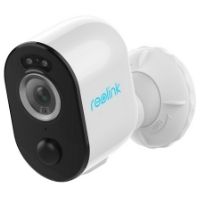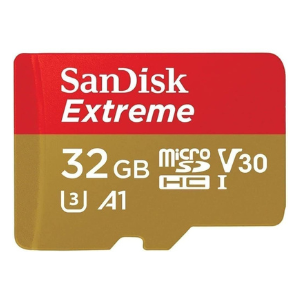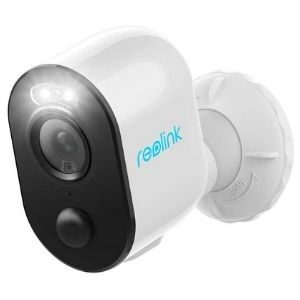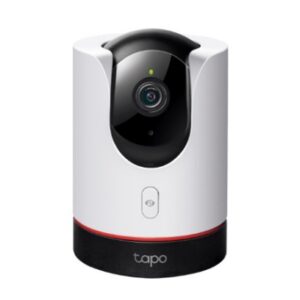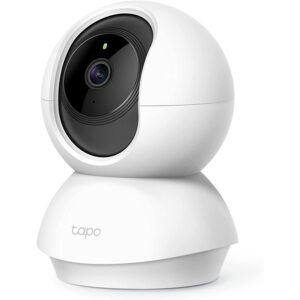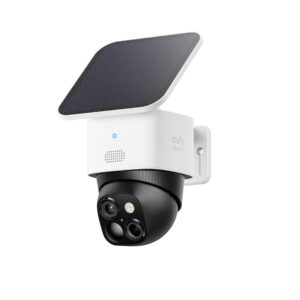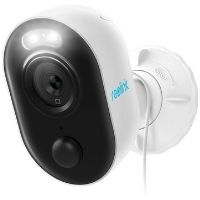Let's explore the differences and costs of local and cloud storage to help you choose the security camera storage option that fits your personal preferences and budget.
Should I choose local or cloud storage for my security camera?
SafeWise experts have years of firsthand experience testing the products we recommend. Learn how we test and review.
Local storage pros and cons
Cloud storage pros and cons
What's the difference between cloud and local storage?
Local storage
As the name suggests, local storage keeps your security camera footage on your camera (or a central hub) without sending any data over the internet. This means you don't need internet or monthly fees for the camera to do its job. Plus, your recordings are less susceptible to data breaches or someone watching them without your permission.
Most security cameras that store local video do it in one of three ways:
- Removable storage (like a microSD card) allows you to swap memory cards between devices. This is a convenient way to watch video footage on a larger screen or transfer files to your computer. The amount of storage a product supports depends on the camera model, but expect to buy cards between 32 GB and 256 GB. MicroSD cards are the most popular type of local storage on brands like Reolink, TP-Link, and Wyze.
- External storage is the traditional method for storing footage from multiple cameras in one place, usually on an NVR or base station. The cameras use video cables or Wi-Fi to link to the NVR, which processes and stores video on a hard drive. This is the most expensive type of local storage because you're usually paying for multiple cameras and an NVR. Multi-camera systems like Swann or Reolink are your best bet for external local storage.
- Built-in storage is part of the camera or its included hub, and there's usually no way to increase it—it's a common way to supplement cloud storage plans. Accessing videos usually requires a mobile app and a Wi-Fi connection. The amount of built-in storage a camera has is generally limited to a few gigabytes. Look to brands like Google Nest and Eufy (HomeBase) for good examples of built-in storage.
Cloud storage
Cloud storage saves your videos behind usernames, passwords, and encryption on a secure remote server. It's wholly dependent on the internet, so there's no way to record videos when your camera's offline. Still, it's great for keeping videos safe from anyone that steals or breaks your camera. Security companies also use cloud storage to add features like person and vehicle detection to your camera.
Cloud storage comes in two flavours:
- Event recording saves short video clips based on a camera's motion detection. These clips usually aren't much longer than a few minutes. This is the most common type of cloud storage because it uses less internet bandwidth and helps battery-powered cameras go longer without recharging. Arlo cameras, the Ring Stick Up Cam, and Nest cameras are great options for event-based cloud storage.
- Continuous recording saves everything a security camera sees. This is ideal for capturing events lasting longer than a few minutes but requires a wired power source and copious amounts of internet bandwidth. Cameras with continuous recording usually use event recording to help you spot activities of interest without sitting through days of surveillance footage. Arlo and Google Nest offer some of the best continuous video recording plans.
Compare local storage vs. cloud storage costs
Local storage is the clear winner if you're aiming to spend as little money as possible since it's a one-time expense without any monthly fees. Still, cloud storage brings a lot of conveniences and just a touch more security—as long as you use online security best practices like a strong password and two-factor authentication. Here's a quick breakdown of the prices you'll encounter to store security camera footage.
Local storage costs
We looked at some of the most popular microSD card models to create a basic picture of what you can expect to spend on local storage. For a 32GB card, you're looking at as little as $10. For 64GB, the price goes up to about $15, while a 128GB card will set you back closer to $30.
We recommend sticking with microSD cards over NVRs since they're very cost-effective, even at higher capacities like 128 GB. NVRs tend to cost around $350 for 2 TB of storage—larger capacities aren't much more expensive—but that's before you start adding cameras, which quickly balloons into the $500 to $2,000 range.
Reolink Argus 3 Pro: Best home security camera with local storage
Price is accurate as of post date. Read full disclaimer.
While the Reolink Argus 3 Pro is our current favourite wireless security camera overall, it's an excellent choice for local storage too. We love that the Argus 3 Pro supports microSD cards up to 128 GB, which can store between 36 and 291 hours of footage.
But what makes this camera so special for local storage is that you can customise the frame rate and bit rate to use as little data as possible. This helps your local storage last longer before it fills up and starts overwriting old recordings.
SanDisk Extreme: Best microSD card
Price is accurate as of post date. Read full disclaimer.
The SanDisk Extreme is a popular little storage device with hundreds of thousands of happy customers. We like that it comes in capacities as low as 32 GB and as high as 1 TB. (It'll be a while before security cameras support that.) It's even quite affordable—like all microSD cards. You can pick one up for around $13 for 32 GB.
The "extreme" part of its name refers to the card's durability, especially in adverse weather conditions. It's waterproof and can handle temperatures between -25°C and 85°C—better than a typical outdoor security camera.
Cloud storage costs
We looked at several cloud storage plans to see how cloud video storage starting costs stack up across the main security camera brands. Prices vary depending on whether you want event recording or continuous recording and how many cameras you have, but plans can start from as little as $5 and go up to (or in excess of) $30 per month.
Most starting prices for cloud storage plans—even with continuous recording—are cheaper than an Amazon Prime membership or Netflix subscription. Still, the costs add up over time, which might put stress on smaller budgets. Fortunately, you can usually save around 17% (or two free months of service) by opting for an annual plan instead.
Ring Protect Plus: Best event recording cloud storage
Price is accurate as of post date. Read full disclaimer.
Ring Protect Plus is the best value for anyone looking to get event-based cloud storage at rock-bottom prices. It supports unlimited cameras and keeps up to 60 days of video history. Plus, you get an extended warranty that covers all of your Ring cameras as long as you're a subscriber.
Google Nest Aware is technically cheaper than Ring Protect Plus at $9 a month. But with only 30 days of event history, we think Ring’s extra cost is worth it.
Google Nest Aware Plus: Best continuous video recording cloud storage
Price is accurate as of post date. Read full disclaimer.
Google Nest Aware Plus supports unlimited cameras on its continuous video plan, which gives Nest a huge advantage over Arlo's single-camera plans. It's a little pricier if you have only one Nest Cam, but it immediately pays for itself with each camera you add.
Which security camera storage option should I choose?
There's a lot to like about both types of camera storage, so it boils down to personal preference. Local storage is hard to beat for affordability, and it doesn't require the internet. On the other hand, cloud storage is convenient and adds a backup layer if something happens to your camera. Or you could use the two options in tandem for the super storage of your dreams.
Compare the best home security cameras in Australia
Prices are accurate as of post date. Read full disclaimer.
